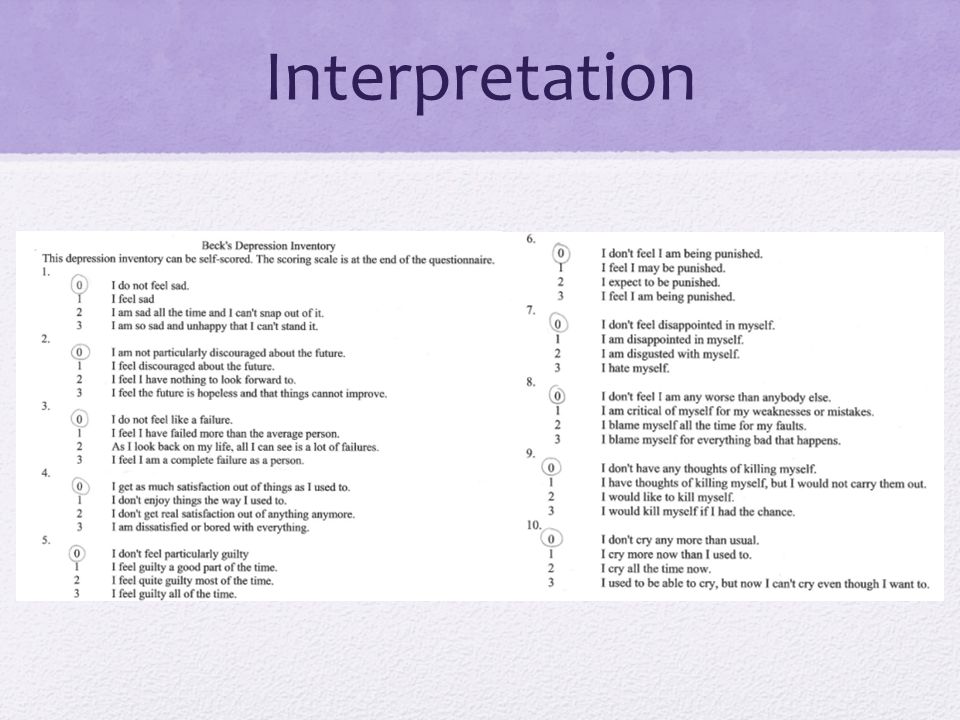Beck Hopelessness Scale (BHS) Construct Validity - Scale used in hypothesis testing relevant to hopelessness. Please see original citation for details. Criterion-Related Validity - Hopelessness scale scores found to correlate with clinical ratings of hopelessness, Stuart Future Test and pessimism item of the Beck Depression Inventory. Description: The Beck Hopelessness Scale (BHS) is a 20-item scale for measuring negative attitudes about the future. Beck originally developed this scale in order to predict who would commit suicide and who would not. The conceptual basis for the scale derives from the writings of the social psychologist Ezra Stotland. The Beck Hopelessness Scale (BHS) is a questionnaire in which a patient answers 'true' or 'false' to a series of 20 statements that test his or her feelings about the future. The purpose of completing the questionnaire is to determine the likelihood that a particular person will attempt suicide.
- Beck Hopelessness Scale Online Test
- Beck Hopelessness Scale Purchase
- Beck Hopelessness Scale Questionnaire
- Beck Hopelessness Scale Questionnaire Online
Unbeatable assessment tools to help patients heal.
The Beck patient assessment tools help healthcare professionals measure patient needs and progress. Their specific applications range from assessing anxiety to youth emotions, and all are available for purchase using the links below.
The Beck Scales for adults and children listed below are not available from Beck Institute, but may be ordered, along with scoring and normative data, from Pearson Assessment, Inc., at 1-800-211-8378 or pearsonassessments.com.


Beck Hopelessness Scale Online Test
Learn More About Cognitive Behavior Therapy
Beck Hopelessness Scale Purchase
The Beck Hopelessness Scale (BHS) is a questionnaire in which a patient answers 'true' or 'false' to a series of 20 statements that test his or her feelings about the future. The purpose of completing the questionnaire is to determine the likelihood that a particular person will attempt suicide. Since the Beck Hopelessness Scale was first tested and used, it has proved to be a valuable tool with a high level of accuracy when attempting to determine a person's risk of suicide. The scale is a derivation of the Beck Depression Inventory, another test used to determine the level of depression a patient is experiencing.
Patients utilizing the scale respond to a series of 20 statements that are phrased in the first person. The patient classifies each statement as true or false, assessing his or her own feelings. At the end, the responses to the statements are totaled according to a key to find the patient's rank on the Hopelessness Scale; a higher number indicates a higher risk of suicide.
The scale rates the patient’s potential for suicide as one of four possible results. A score of 3 or lower means there is a minimal risk of suicide. A score between 4 and 8 indicates a mild risk. Scores that range from 9 to 14 indicate a moderate chance of suicide, while scores of 15 or higher show a severe risk of suicide. The reliability of the Beck Hopelessness Scale is very high and has been shown to be a very good assessment of risk.
More than half the assessment statements on the Beck Hopelessness Scale were adapted from statements actually made by psychiatric patients who were diagnosed as being in a depressed and hopeless frame of mind. The remaining questions on the test were constructed as being neutral statements relating to hopeless attitudes about the future. Through peer review, the statements were carefully scrutinized and reworded to be as clear and neutral as possible.
Beck Hopelessness Scale Questionnaire

Beck Hopelessness Scale Questionnaire Online
The Beck Hopelessness Scale was tested extensively on groups of patients who were in high-risk groups. It also was later tested on groups that were substance abusers, excluding alcoholics. The questionnaire was shown to be highly accurate when administered to high-risk patients and drug users who were adults. The validity of the test is unknown for children and is slightly less accurate when given to patients who are not in a group that is at a high risk for suicide.